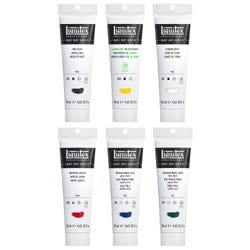Abstract Painting: Exploring Various Brush Strokes

Description
Lesson Plan and Artwork by Joe Culotta
This lesson teaches how the various brush strokes can be applied to execute a creative abstract painting on canvas. Students will have an opportunity to experiment with the following brush types:
- Rounds - Strokes, general coverage
- Liner/ Pointed Rounds - lines, details, lettering
- Bright - Strokes, general coverage, chisel lines, floats
- Flat - Longer than brights & not as firm
- Angular - Strokes, tight area coverage
- Filbert - Rounded strokes, blending
- Fan - Washes, stippling, glazing
- Mop - Washes, blending, glazing
Objectives
- Research contemporary Art Movements such as: Cubism, Pop Art, Expressionism.
- Research contemporary artists: Braque, Picasso, Jasper Johns.
- Gain an understanding of the term “Abstract” as an art form.
- Learn how the basic art elements (Line, Color, Form, Shape and Texture) are utilized to create an abstract painting.
Supplies Needed
Fredrix® Stretched Cotton Canvas, 18 X 24 Inches, White, Pack of 3
Sax® True Flow® Tempera Varnish, Matte Finish, 1 Gallon
Dynasty® Faux Camel Hair Brush Canister, Rounds and Flats, Set of 108
Liquitex® Heavy Body Acrylic Paint Set, 4.65 Ounce Large Tube, Assorted Color, Set of 6
*Here are the supplies needed for this lesson plan for reference. Find a convenient carousel of shoppable products for this lesson below.
Standards
Standard #1: Generate and conceptualize artistic ideas and work.
Standard #2: Organize and develop artistic ideas and work.
Standard #3: Refine and complete artistic work.
Standard #4: Select, analyze and interpret artistic work for presentation.
Standard #5: Develop and refine artistic work for presentation.
Standard #6: Convey meaning through the presentation of artistic work.
Standard #7: Perceive and analyze artistic work.
Standard #8: Interpret intent and meaning in artistic work.
Standard #9: Apply criteria to evaluate artistic work.
Standard #10: Synthesize and relate knowledge and personal experiences to make art.
Standard #11: Relate artistic ideas and works with societal, cultural and historical context to deepen understanding.
Instructions
1
Research various art movements/contemporary artists.
2
Use a sketchbook to draw and develop abstract ideas. These ideas will become the basis to execute your abstract design on the canvas.
3
Practice the various techniques and brush strokes to be utilized.
4
Sketch your design idea onto the canvas. Allow the brush strokes to create elements such as motion, pattern, rhythm, and repetition to develop your composition. The following brush techniques can be used:
- Mix colors together while painting wet-on-wet using (mop brush) for blending
- Bring texture into the work by scrapping across with a pallet knife or (fan) brush.
- Paint smooth and blended areas to rest the eye and reinforce texture and color (filbert brush)
5
The painting with modifications will resemble the original design and sketch ideas.
6
Multi-Media Varnish can be applied to the finished work (optional).
7
Have students critique their work and describe how they used the various brush strokes to create their abstract design.




